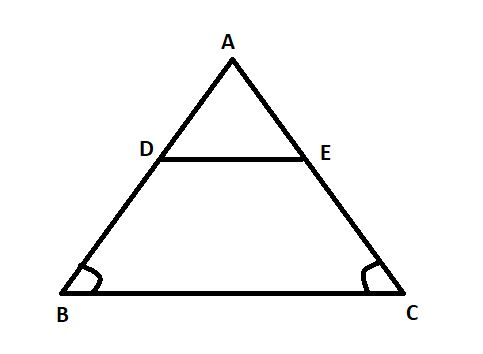
Answer
500.7k+ views
Hint: - Here, we go with the property of parallel lines and with the property of cyclic quadrilaterals. In a cyclic quadrilateral, the sum of either pair of opposite angles is supplementary.
In order to prove that the points ${\text{B,C,E}}$and ${\text{D}}$ are concyclic, it is sufficient to show that \[\angle ABC + \angle CED = {180^0}\] and \[\angle ACB + \angle BDE = {180^0}\].
In\[\;\vartriangle ABC\], we have
\[AB = AC\]And \[AD = AE\]
\[
\Rightarrow \;AB - AD = AC - AE \\
\Rightarrow \;DB = EC \\
\]
Thus, we have
\[AD = AE\;\]And \[DB = EC\;\]
\[ \Rightarrow \frac{{AD}}{{DB}} = \frac{{AE}}{{EC}}\]
\[ \Rightarrow \;{\text{ }}\;DE\mid \mid BC\;{\text{ }}\] [By the converse of Thales Theorem]
\[ \Rightarrow \;{\text{ }}\;\angle ABC = \angle ADE\;{\text{ }}\;{\text{ }}\] [Corresponding angles]
\[ \Rightarrow \;{\text{ }}\;\angle ABC + \angle BDE = \angle ADE + \angle BDE\] [Adding \[\angle BDE\]both sides]
\[ \Rightarrow \;\;\angle ABC + \angle BDE = {180^0}{\text{ }}\] \[\because \angle BDE + \angle ADE = {180^0}\](Straight angle)
\[ \Rightarrow \;{\text{ }}\;\angle ACB + \angle BDE = {180^0}\] [\[\because AB = AC\]And\[\therefore \angle ABC = \angle ACB\]]
Again, \[DE\mid \mid BC\]
\[ \Rightarrow \;{\text{ }}\;\;\angle ACB = \angle AED\]
\[ \Rightarrow \;{\text{ }}\;\angle ACB + \angle CED = \angle AED + \angle CED\;\] [Adding \[\angle CED\]both sides]
\[ \Rightarrow \;\;\angle ACB + \angle CED = {180^0}\] \[\because \angle AED + \angle CED = {180^0}\](Straight angle)
\[ \Rightarrow \;\;\angle ABC + \angle CED = {180^0}\] [\[\because \angle ABC = \angle ACB\]]
Thus, \[BDEC\] is a cyclic quadrilateral because the sum of alternate angles are supplementary Hence ${\text{B,C,E}}$and ${\text{D}}$ are concyclic points.
Note:-This question is based on the property of parallel lines and their corresponding angles and also on the property of the isosceles triangle. By applying these properties we can easily solve such types of questions for showing cyclic quadrilaterals
In order to prove that the points ${\text{B,C,E}}$and ${\text{D}}$ are concyclic, it is sufficient to show that \[\angle ABC + \angle CED = {180^0}\] and \[\angle ACB + \angle BDE = {180^0}\].
In\[\;\vartriangle ABC\], we have
\[AB = AC\]And \[AD = AE\]
\[
\Rightarrow \;AB - AD = AC - AE \\
\Rightarrow \;DB = EC \\
\]
Thus, we have
\[AD = AE\;\]And \[DB = EC\;\]
\[ \Rightarrow \frac{{AD}}{{DB}} = \frac{{AE}}{{EC}}\]
\[ \Rightarrow \;{\text{ }}\;DE\mid \mid BC\;{\text{ }}\] [By the converse of Thales Theorem]
\[ \Rightarrow \;{\text{ }}\;\angle ABC = \angle ADE\;{\text{ }}\;{\text{ }}\] [Corresponding angles]
\[ \Rightarrow \;{\text{ }}\;\angle ABC + \angle BDE = \angle ADE + \angle BDE\] [Adding \[\angle BDE\]both sides]
\[ \Rightarrow \;\;\angle ABC + \angle BDE = {180^0}{\text{ }}\] \[\because \angle BDE + \angle ADE = {180^0}\](Straight angle)
\[ \Rightarrow \;{\text{ }}\;\angle ACB + \angle BDE = {180^0}\] [\[\because AB = AC\]And\[\therefore \angle ABC = \angle ACB\]]
Again, \[DE\mid \mid BC\]
\[ \Rightarrow \;{\text{ }}\;\;\angle ACB = \angle AED\]
\[ \Rightarrow \;{\text{ }}\;\angle ACB + \angle CED = \angle AED + \angle CED\;\] [Adding \[\angle CED\]both sides]
\[ \Rightarrow \;\;\angle ACB + \angle CED = {180^0}\] \[\because \angle AED + \angle CED = {180^0}\](Straight angle)
\[ \Rightarrow \;\;\angle ABC + \angle CED = {180^0}\] [\[\because \angle ABC = \angle ACB\]]
Thus, \[BDEC\] is a cyclic quadrilateral because the sum of alternate angles are supplementary Hence ${\text{B,C,E}}$and ${\text{D}}$ are concyclic points.
Note:-This question is based on the property of parallel lines and their corresponding angles and also on the property of the isosceles triangle. By applying these properties we can easily solve such types of questions for showing cyclic quadrilaterals
Recently Updated Pages
Fill in the blanks with suitable prepositions Break class 10 english CBSE

Fill in the blanks with suitable articles Tribune is class 10 english CBSE

Rearrange the following words and phrases to form a class 10 english CBSE

Select the opposite of the given word Permit aGive class 10 english CBSE

Fill in the blank with the most appropriate option class 10 english CBSE

Some places have oneline notices Which option is a class 10 english CBSE

Trending doubts
Fill the blanks with the suitable prepositions 1 The class 9 english CBSE

How do you graph the function fx 4x class 9 maths CBSE

Which are the Top 10 Largest Countries of the World?

What is the definite integral of zero a constant b class 12 maths CBSE

The Equation xxx + 2 is Satisfied when x is Equal to Class 10 Maths

Differentiate between homogeneous and heterogeneous class 12 chemistry CBSE

Define the term system surroundings open system closed class 11 chemistry CBSE

Full Form of IASDMIPSIFSIRSPOLICE class 7 social science CBSE

Change the following sentences into negative and interrogative class 10 english CBSE





